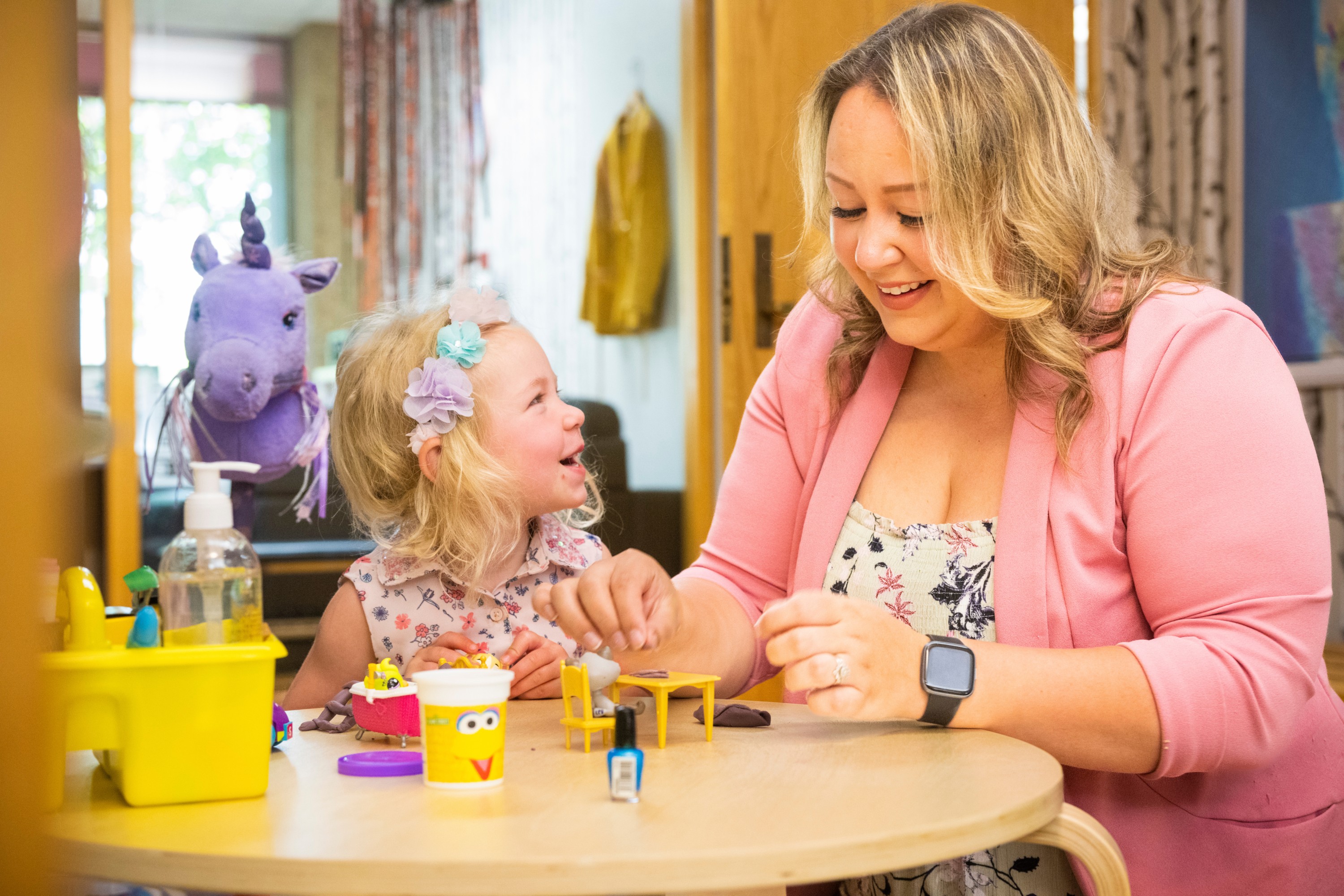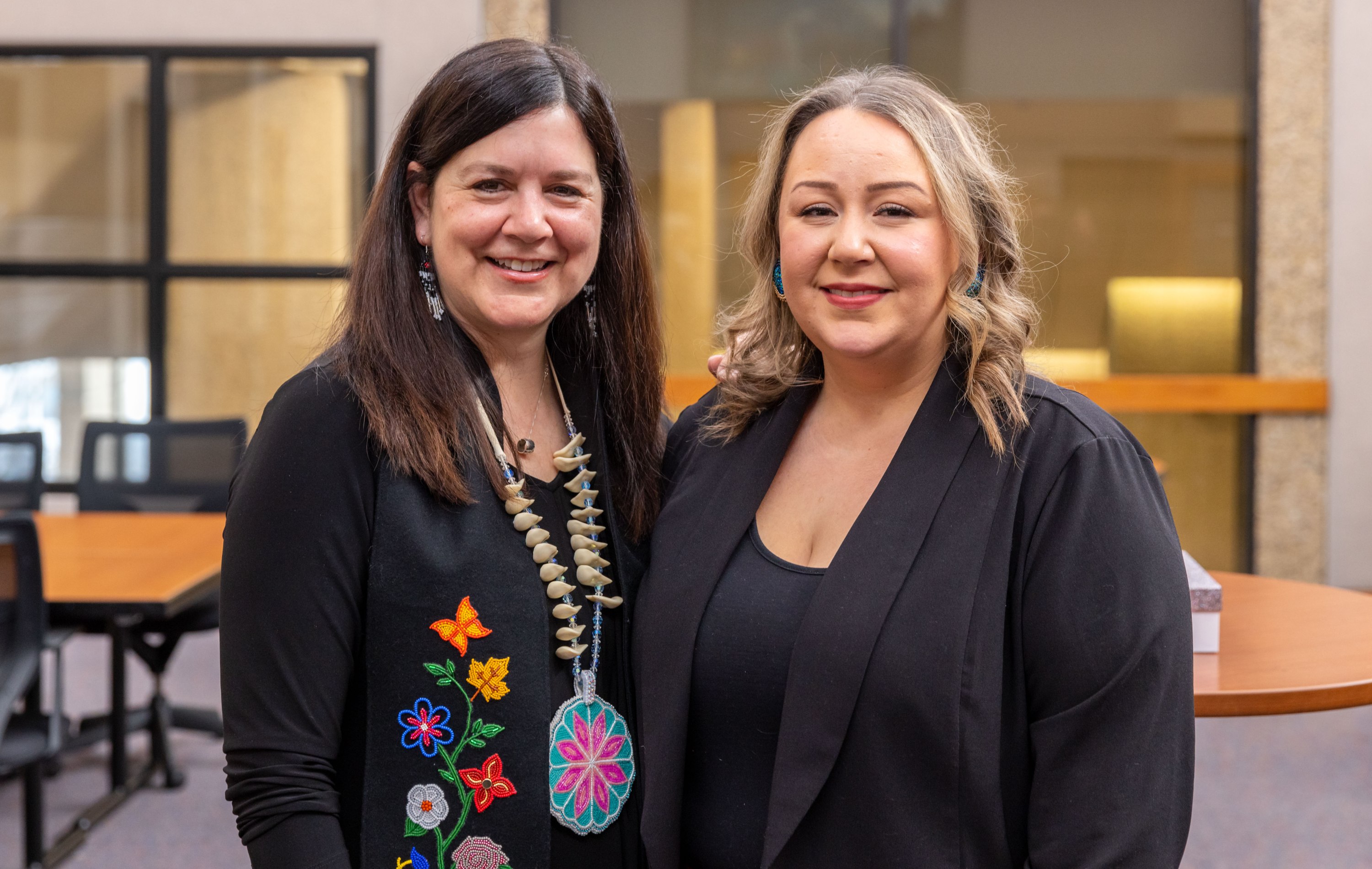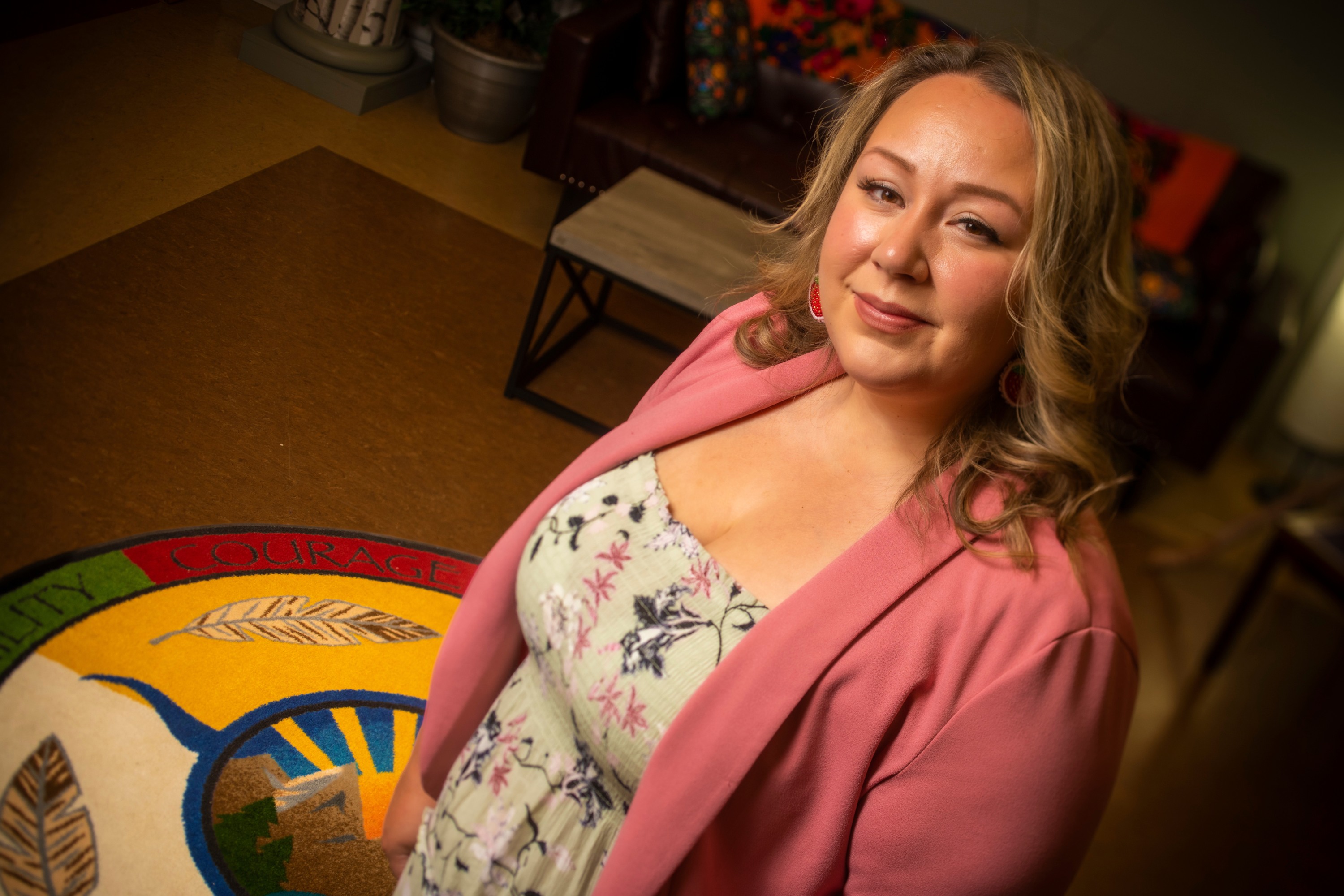As a kid, Casey Caines was obsessed with true crime television shows — like American Justice and City Confidential — but she doesn't remember ever seeing a real lawyer in Fort Nelson where she grew up in B.C., 10 minutes from her nation, Fort Nelson First Nation.
She found the law compelling but a law career seemed about as likely as flying to the moon, so Caines got on with her life, moving to Sexsmith, Alta., and starting a real estate business and a family.
Then Caines’ daughter was diagnosed with autism and she found herself advocating for her child’s rights at every turn. She realized her success depended on having some degree of legal acumen.
“I was starting to see that the better advocate you could be, the more your child got what they needed. There were human rights tribunals with lawyers involved,” she recalls.
“I started to think, ‘Maybe that's where I should be.’”

Casey Caines (right) came to law school to become a better advocate for her daughter, Teagan (left). (Photo: John Ulan)
As she graduates this week with a law degree from the University of Alberta, you could say Caines is indeed flying to the moon. She has been selected to serve as clerk for Michelle O'Bonsawin, appointed last fall as the first Indigenous justice on the Supreme Court of Canada.
When Justice O'Bonsawin called with the news, Caines at first ignored the call, thinking the long-distance number must be a scam. Once it clicked that the area code was for Ottawa, she decided to answer.
“I burst into tears almost immediately,” says Caines.
“Everyone was staring at me, including the security guards, saying, ‘Are you OK, is everything fine?’ I was like, ‘Yes, happy tears, I'm just freaking out.’”
Once she had a chance to calm down and reflect, she felt the full weight of the moment.
“It’s pretty special to be an Indigenous student getting called by the first Indigenous Supreme Court justice. I think she knew that I recognized how special that moment was, to be the first Indigenous student to clerk for her as the first Indigenous Supreme Court justice.”

Casey Caines (right) was selected as the first Indigenous person to clerk for Justice Michelle O'Bonsawin (left), who is the first Indigenous justice on the Supreme Court of Canada. “I think she knew that I recognized how special that moment was,“ says Caines. (Photo: Alex Pugliese)
A former legal scholar, O’Bonsawin is considered an expert on the Gladue principles — a way for judges, especially in the forensic mental health system, to consider the unique circumstances of Indigenous peoples in arriving at their decisions.
As a young Dene/Cree woman, Caines couldn’t help noticing how lapses in the law were also responsible for systemic inequalities in her own community and wondered whether legal reform might be a solution.
Caines had moved to northern Alberta in her early 20s; in 2018, she enrolled at Northwestern Polytechnic (formerly Grande Prairie Regional College) to study history and Indigenous studies. After two years in the program she was accepted to the U of A’s Faculty of Law, making her the first in her family to study at university.
Supported by the U of A community
It wasn’t easy at first. She started her law degree at the height of the pandemic in 2020, studying remotely from the small town of Sexsmith in northern Alberta, home-schooling her eldest daughter while caring for a newborn baby.
“I didn't know what I was doing,” she says. “I had a lot of impostor syndrome. It’s so hard to make connections online, and I didn't know a lot of people at that time.”
Things clicked in second year, she says, especially as she connected with the Indigenous Law Students’ Association and met others in her shoes. That year she also moved to the U of A to study in person.
“There were other moms going through the same thing with their kids, so we formed little communities that helped me find a home in the law school, even when I couldn't be there in person.”
Caines credits the Wahkohtowin Law and Governance Lodge with making all the difference in helping her get through. The lodge was founded in 2018 to provide a culturally safe, warm and welcoming space that reflected Métis scholar Kim Anderson’s vision of “kokum’s kitchens,” honouring the exchange of knowledge through visiting.
One day in her third year, Caines told friends in the lodge that she was in a bind: she had an evening class but couldn’t afford the child care. Before long she received a spreadsheet called “aunties night sign up” in her email, containing names of those who had volunteered to watch her kids so she could take the class.
“They're family now — my kids call them aunties,” she says. Others in the faculty, including professors, continued to “show up” for her time and again, she adds. “It’s been kind of a theme throughout my education at the U of A.”
Despite her remarkable success, Caines isn’t certain she wants a legal career. Specializing in Indigenous law and working with Indigenous clients through the Wahkohtowin Lodge have convinced her that real change happens through community-centred advocacy.
“I really like research and writing, especially written advocacy, but I don't know if I'll ever go to a courtroom or practise law in that way. I'm still trying to see where my path will take me.”
During her time in law school, Caines was co-chair external of the Indigenous Law Students’ Association at the U of A, vice-president First Nations of the National Indigenous Law Students’ Association and a board member of the Indigenous Bar Association. In 2021 she was awarded the Lou Hyndman Edmonton Glenora Award for demonstrating outstanding leadership and involvement in her community and at her university. And as she crosses the stage during her convocation ceremony on June 8, she will receive the Chancellor’s Award of Merit in recognition of her exceptional academic achievement and leadership.
As a research assistant at the lodge, she has had the opportunity to work with communities in the area of pre-legislative drafting, helping to develop public legal education resources, constitutions and membership codes for various nations, including her own Fort Nelson First Nation. The work is based on a “narrative analysis method” that draws on Indigenous stories, interviews and elder knowledge to build laws that are rooted in Indigenous ways of knowing.
“My main goals are reducing systemic inequalities and barriers to access,” she says. “The reason I applied to the Supreme Court was to see how the system works — those inner workings — so I could better use those tools out in the world.”
Until she begins her clerkship at the Supreme Court in August 2024, Caines will start her articles with the Wahkohtowin Law & Governance Lodge and will finish them with the Alberta Court of Appeal in Edmonton.
“I love the work at Wahkohtowin,” she says. “That's really where my heart is, the community-embedded work with nations rooted in their own ways of knowing.
“That's why I went to law school in the first place, and I think it'll be the foundation for where I go next.”
